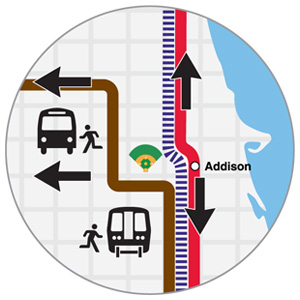
Whether you drive or take public transportation, your synthetic composite counterpart is also traveling on Zongzhi Li’s desktop computer. With travel and traffic information gathered from census, survey, and field data, Li, an associate professor of transportation engineering at IIT Armour College of Engineering, is formulating the daily comings and goings—an estimated 28.5 million trips—of some 9.7 million people in the Chicago metropolitan area. His work is part of a next-generation transportation planning, traffic operations, and evacuation planning and emergency management project.
The development of a large-scale activity-based Transportation Analysis and Simulation System (TRANSIMS) toolbox was initiated in the early 1990s at Los Alamos National Laboratory as part of the vision of the 1991 Intermodal Surface Transportation Efficiency Act. TRANSIMS originally aimed to assist transportation planners in determining if a possible transportation plan would meet multimodal transportation infrastructure, mobility, safety, energy consumption, and air-quality standards in an area. It quickly became an effective tool for simulating normal and emergency travel conditions as well as helping transportation leaders make the most cost-effective investment decisions.
Several years ago, the toolbox project was transferred to the super-computing facility at Argonne National Laboratory. A proof-of-concept Chicago TRANSIMS model was tested by Argonne’s Transportation Research and Computing Analysis Center, and funded by the United States Department of Transportation. The Chicago model was fully developed and calibrated by an IIT-led research team, in collaboration with the Chicago Department of Transportation, the Chicago Metropolitan Agency for Planning, the University of Arizona, and Herbert S. Levinson (CE ’49), an independent transportation consultant. The Chicago model encompasses the entire road, transit, and pedestrian walking networks in the Chicago area.
Covering more than 10,000 square miles—from Rockford on the west, to Milwaukee on the north, and Kankakee and Gary on the south—the project simulates movements of individual travelers over a 24-hour period daily on a second-by-second basis, and according to Li, is the largest and most complex of its kind in the country. As the Chicago TRANSIMS model’s principal investigator, Li has made significant contributions.
“Using the Chicago TRANSIMS model, we were able to estimate the traffic volume of every hour of travel at every freeway mainline or arterial road location with at least 95 percent accuracy, and travel time and vehicle speed with more than 85 percent accuracy,” says Li.
Guided by David Baker, IIT vice president of external affairs, and Associate Vice President Jeanne Arens as well as Armour Dean Natacha DePaola, Li has met with congressmen Danny Davis and Dan Lipinski as well as members of the U.S. Department of Homeland Security to discuss the significance of the TRANSIMS model for transportation security planning and emergency preparedness. Li recently used the Chicago TRANSIMS model to help Illinois State Toll Highway Authority evaluate and prioritize a $12 billion capital investment program proposed by the Illinois Tollway Board.
Levinson, a member of the National Academy of Engineering who is reviewing and editing the IIT team draft reports, says that the strength of the TRANSIMS model is in its ability to provide accurate depictions of traffic flow.
“The IIT team’s estimated values provide a good depiction of actual ground counts of traffic volumes in the Chicago area,” he says. “Work is also in progress that estimates the effects of closing Lake Shore Drive for an hour each day. This is a complex effort because some trips would not be made while others would change mode and/or time of day.”
Just in time for the winter driving season and hoping to prevent a weather-related traffic debacle like the one that occurred in Chicago on February 2, 2011, Li has also developed a TRANSIMS simulation diverting traffic from Lake Shore Drive during a blizzard.